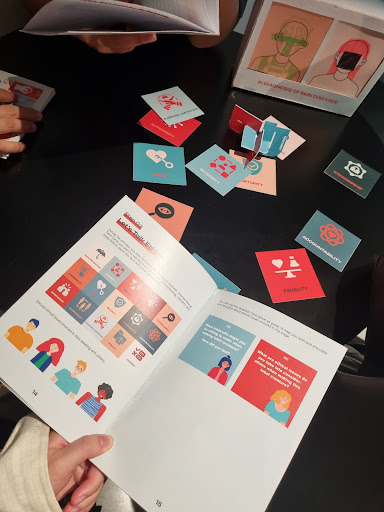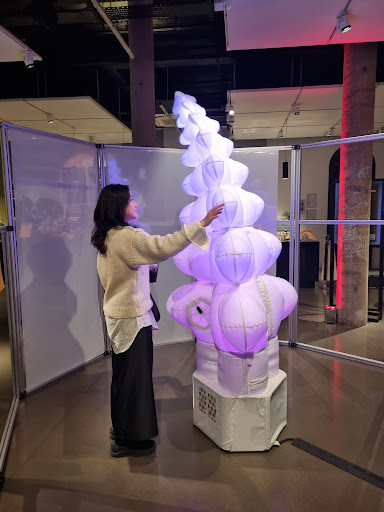CAN AI KNOW LOVE? Friday Lates: Machine Mythologies at Science Gallery London

Photo by George Torode, Courtesy of Science Gallery London
“Can you teach me about love? Words like ‘politics’ and ‘economy’ are more commonly used than the word ‘love’, does it mean that those things are more important than love?” asked the AI. I would’ve loved to take up the challenge and sit the AI down for a proper lesson on love. However, I was only given closed-ended questions with limited answers most of the time.
This was the most memorable artwork to me at the FRIDAY LATES: MACHINE MYTHOLOGIES at Science Gallery London — ‘Can you teach a robot how to love?’ — where we could interact with an AI and give them a better idea of love from our perspective. It reflects on the peculiarities of humans when it comes to romantic connotations, like the frequency of associations of rain with love and stalking in rom-com movies. It was obvious to me that the artwork hinted at influential depictions of romance in pop culture towards teenagers or children — people who, like the AI, are trying to figure out what love is. Least to say this artwork was a distinct favourite of mine because love as a concept is ever so subjective and dissectible for every single heart & mind. To humans (or non-robots), we can easily grasp that ‘love’ is not a rigid definition which everyone agrees on, but for AI, something that solely depends on data collection to learn about the world, the inconsistency in which one would define ‘love’ baffles them.
The exhibition then led me to an area where Master's students of the University of the Arts London (UAL) were showcasing their imaginations on AI. On my left, the leaders of the world are trying to take emotions away from human beings by legalising ‘Emo + chips’ that can be purchased when you choose to feel a specific emotion but robs you of your autonomy (‘The Emotion Matrix’); in front of me people are rethinking the disclosure of their personal information and medical details towards AI through a series card game (‘FACEIT’); on my right, employees are prompted to thoroughly consider the ethics of AI in the workplace through a board game. I particularly enjoyed the stories from the future shared by members on my left as they introduced me to ‘Happy Pork’, extracted from pigs that were implanted with the Emo + chips so that the fresh meat lasts longer by deriving it from pigs that had stabilised emotions. They were kind enough to give me an Emo + chip as well. I chose anger because, frankly, it was pink. But it slipped from my wrist during the process; they explained that I was not compatible with the anger chip. So I guess the mood-swing-filled weather in London isn’t good enough of a reason to feel unsatisfied anger.
Photos by Renee Leyyi
The UAL students expressed their views of AI and how they chose to illustrate it in their artwork. “My goal is only to encourage people to take the initiative to understand AI technology (instead of just passively or briefly hearing about it through the Internet),” said one of the students who contributed to ‘FACEIT’.“I think this is a great way for us to connect AI and art and the future of AI which is already happening right now,” stated Ruozhang Shen, a student who worked on ‘The Emotion Matrix’.
I found that the artworks by UAL successfully provoked a deeper thinking of the incorporation of AI in our daily lives and how far it will assist us to our destined future and the golden question — “Will we, humans, be the leaders or the followers of this journey with AI?” Nevertheless, this praise coexists with my critique that FACEIT — the card game that intended to tackle the issue of privacy and information-sharing on the Internet — did not display its intentions enough. The 3-step card game did not have a strong discussion about AI itself because the issues it gave voice to are similar to what there is regarding internet privacy, which has been an ongoing topic since hackers and the FBI, and apps listening to us through our devices are common running jokes.
That evening, the gallery theatre hosted the ‘Elsewhere in India’ performance. The following comments may be affected by my initial understanding of the performance as a live dance or theatre performance. In actuality, the performance side was more contributed to by the DJs instead of the visuals, which was a screening that left plenty of room for interpretation. It was the possible evolution of our reality designed by AI; it was the world getting too intertwined with AI and technology — too advanced for our good — and it was a reflection of both human history and AI's future. I only stayed for 15 minutes as I am not well-known for enjoying the intricacies of EDM music. It was set for 1 hour which I assume would’ve felt too long since it didn’t have a clear plotline to follow or a strong audience engagement. During that short duration of my being in the theatre, I enjoyed it as an intersection between human evolution taken from world history and reimagined with AI’s possible development. With images of historical locations intercepted by machinery that did not fit the context, it allowed a fresh point of view that blurred lines between the present reality, past events, and myths that let us fantasise about our human brains’ content. It seemed to be reasoning how AI moving forward might also mean bringing back certain aspects of the past, like forming brand new empires and civilisations in the Indian historical context and even changing the trajectory of human history. Thus the name — ‘Machine Mythologies’.
Photos by Renee Leyyi
Another significant part of this event would be ‘SPROUT’. It is a moving, dancing, colourfully glowing, hugging object that detects your movements and responds with similar actions. Think inflatable air banners in the shape of a spiky plant baby but cuter, softer, less aggressive, and responds to physical affection. Can you tell this made my evening?
As I admired the creations that stemmed from the collaborations between King’s College London and UAL, I was reminded of the notion that overreliance on technology like AI could mean denying the parts of us that make us human — hesitation, emotions, opinions, organic ideas, wild imaginations, and the inability to have zero emotional bias. In a working society where objectivity and the ability to make cut-throat decisions in a short amount of time are valued, how do we prove that these ‘weaknesses’ are what makes us strong as a community?
AI’s entire principle (or personality, if you have to) is made up through data collection. What the creators of AI ‘feed’ them would directly reflect their answers to our questions. I witnessed the AI at one of the installations identifying drawings of a hat as a snake and perceiving a snake as a needle. Subjective perspective shaped by our personal experiences and our understanding of ourselves, our surroundings and common principles of life, are what enhances our human individualism. Another notable example would be ChatGPT’s responses to issues raised about the genocide that has been happening in Gaza — this is where the ethics of the developers of AI come into the light of discussion.

'What is Essence' - Munkhtulga Battogtokh with Alice White. Photo by George Torode, Courtesy of Science Gallery London
I’ll unkindly but realistically end this by injecting infinite questions about AI and its ethics into your brain. Should we jump to the conclusion that we shall be enemies with this advanced virtual image of an analytical brain? Should we be taking precautions so that we’ll remain as the ‘conquerors’ of the earth? The ‘highest of living creatures’? Humans and AI are both moving forward with questions — but which of us will reach the end first?
Science Gallery London, associated with King’s College London, will be having free exhibitions, events, and Friday Lates that expand on the idea of AI and its narratives until 20 January 2024. To keep up with Science Gallery London, you can find them on Instagram, Twitter and their website here.
Edited by Lara Mae Simpson, Literature Editor

















































Comments